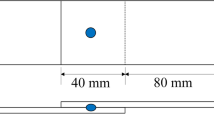Abstract
Resistance spot welding is the major joining technique in mass car production. This applies in particular to high-strength steel and advanced high-strength steel (AHSS) joining of thin sheet steel components for lightweight body shell structures. Joining of AHSS in mass production might lead to weld discontinuities under certain circumstances. Those discontinuities in form of cracks might be an initial start of cracking in the spot-welded joints regarding fatigue loads. It is of great interest to figure out, if, in comparison to specimens without weld discontinuities, the crack initiating point changes and if the fatigue resistance might be reduced by the discontinuities. In this contribution, an overview of potential discontinuities is given. Their possible causes are discussed and means for their detection are highlighted. Among the possible causes of weld discontinuities, two major groups are distinguished: the welding parameters as primary influences in the welding process, and the production-specific influences as secondary ones. With emphasis on major cracks penetrating the weld nugget, these influences are analysed. Finally, a combination of extreme welding parameters with production-specific influences is chosen in order to establish a method which enables the preparation of fatigue test specimens with reproducible major cracks in different locations of the spot-welded joints. This method is then applied in order to prepare spot weld specimens for fatigue tests.
Similar content being viewed by others
References
Franz T.: Application of ultra high strength steel in the automotive processing chain, Steels in Cars and Trucks, 2008, vol. 2, pp. 354–357.
Osburg B., Patberg L., Grüneklee A., Flöth T., Große-Gehling M., Hin, M. and Mebu, H.: New steel body — safer and more economical light-weight car body production with steel, Automobiltechnische Zeitschrift ATZ, 2004, vol. 106, no. 3, pp.190 (in German).
Wesling V., Rekesdrees T., Keitel S., Winkler R. and Schreiber S.: Investigations into the resistance spot welding of newly developed sheets made of higher-strength and super-high-strength steels, Welding and Cutting, 2004, no. 3, pp. 168–173.
Sierlinger R., Szinyur J. and Ritsche S.: Weldability and performance characteristics of spot-welded advanced high strength steels, Eurojoin, 2004, no. 5, pp. V10.
Fritzsche C. and Laurenz R.: Spot welding of cold-rolled advanced high strength steels - DVS 2935-2, DVS-extraordinary meeting “Resistance welding”, 2007, no. 20, pp. 33–40 (in German).
Weber G. and Göklü S.: Resistance spot welding of advanced high-strength steels, Welding in the World, 2005, vol. 49, Special Issue, pp. 134–155.
Weber G. and Göklü S.: Resistance spot welding of uncoated and zinc coated Advanced High-Strength Steels (AHSS) — Weldability and process reliability-influence of welding parameters, Doc. IIW-1722, Welding in the World, 2006, vol. 50, no. 3/4, pp. 3–12.
Maggi S. and Murgia M.: Introduction to the metallurgic characteristics of advanced high-strength steels for automobile applications, Welding International, 2008, vol. 22, no. 9, pp. 610–618.
Bertsch M. and Ruther M.: Adaptive weld control as innovative production technology in volume production, Steels in Cars and Trucks, 2008, 2, pp. 350–354.
Hofmann H., Becker J.U., Göklü S., Richter H. and Thomas I.: X-IP 1000: Properties of an austenitic super high strength high manganese steel — status and outlook, Steels in Cars and Trucks, 2008, 2, pp. 34–42.
Hsu C.A., Lee P.K., Hsieh C.K. and Weng T.F.: Fracture analysis on spot weld nugget of advanced high strength steels, Proceedings of the Baosteel Biennial Academic Conference, 2008, 3, pp. D38–D42.
Hahn O. and Flüggen F.: Influence of cyclic loading on the structural behaviour of spot-welded joints with regard to the design for crash relevant components, DVS-extraordinary meeting “Resistance welding”, 2010, no. 21, pp. 180–191 (in German).
Ritsche S. and Sierlinger, R.: Influence of imperfections on the structural behaviour of spot-welded advanced high strength steels, DVS-extraordinary meeting “Resistance welding”, 2007, no. 20, pp. 40–46 (in German).
Khan M.S., Bhole S.D., Chen D.L., Biro E. and Boudreau G.: Welding behaviour, microstructure and mechanical properties of dissimilar resistance spot welds between galvannealed HSLA350 and DP600 steels, Science and Technology of Welding and Joining, 2009, vol. 14, no. 7, pp. 616–625.
Zhang H. and Senkara J.: Resistance welding, Fundamentals and applications, CRC/Taylor & Francis, Boca Raton, Fla., 2006.
Watanabe G. and Tachikawa H.: Behaviour of cracking formed in aluminum alloy sheets on spot welding, IIW Doc. No. III-1041-95, 1995, pp. 1-13.
Gaul H., Brauser S., Weber G. and Rethmeier M.: Fatigue strength investigations for spot-welded joints of advanced high strength steels taking account of fabrication-specific influences, FOSTA-Project P802, 2011 (in German).
Author information
Authors and Affiliations
Rights and permissions
About this article
Cite this article
Gaul, H., Brauser, S., Weber, G. et al. Methods to Obtain Weld Discontinuities in Spot-Welded Joints Made of Advanced High-Strength Steels. Weld World 55, 99–106 (2011). https://doi.org/10.1007/BF03321547
Published:
Issue Date:
DOI: https://doi.org/10.1007/BF03321547




